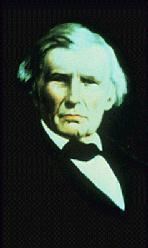Name William Conner | ||
 | ||
Parent(s) Richard Conner and Margaret Conner Spouse Elizabeth Conner (m. 1802) | ||
William conner
William Conner (December 10, 1777 – August 28, 1855) was an American trader, interpreter, scout, community leader, entrepreneur, and politician. Although his first trade was a fur trader, his later business interests included farming, milling, distillation of spirits, mercantile endeavors, and land speculation.
Contents
- William conner
- Conner Prairie William Conner House The Conners Bedroom
- Early life
- Settlement in Indiana and Hamilton County
- William Conners house
- References
William Conner's older brother, John is notable to Indiana history for platting the town of Connersville, Indiana. William founded Hamilton County and its county seat Noblesville. William Conner served as an interpreter for the American forces in the War of 1812, and later served as an interpreter and witness at several treaty negotiations with Native American groups which would result in Indiana having its modern-day boundaries. Conner served three non-consecutive terms as a state representative in the Indiana House of Representatives between 1829 and 1837.
Conner was a charter member of the Indiana Historical Society and a member of the Masonic Order.
Conner Prairie is a living history museum in Fishers, Indiana that bears his name and is located on his original property. It includes Conner's original brick home.
Conner Prairie - William Conner House: The Conners' Bedroom
Early life
William Conner was born in what is now Tuscarawas County, Ohio, in 1777. Conner's family traveled with Moravian missionaries and their Delaware converts. The Conners joined the Delaware and the missionaries on their British-forced removal to Michigan. William's father, Richard, would go on to settle in Michigan in an area later to become Macomb County, Michigan.
Settlement in Indiana and Hamilton County
Conner and his older brother John arrived in Indiana during the winter of 1800-1801 as agents for a Canadian fur trader named Angus Mackintosh. Conner and his brother would become officially licensed traders by 1801. They would later settle among the Delaware along the White River. Conner married the Delaware woman Mekinges Conner in 1802, whose name meant Dancing Feather. She was the daughter of Delaware Chief Kikthawenund, also known as Chief William Anderson, the namesake of Anderson, Indiana. They would have six children.
Beginning in 1808, Conner served in several capacities under William Henry Harrison and others. He helped maintain Delaware loyalty during the War of 1812. Conner would later serve as an interpreter and liaison at the Treaty of St. Mary's in 1818, in which the Delaware ceded lands in central Indiana for those west of the Mississippi River. William Conner, Mekinges Conner husband was an interpreter at this Treaty.
In 1818 he petitioned to secure legal right to his land from the Delaware, who had signed a treaty to move west of the Mississippi River by 1820. Upon securing his petition in 1820, Conner divided assets with his business partner William Marshall and provided his own family with horses and goods. Mekinges decided to move west with the Delaware, and she took their six children with her. Conner chose to stay and gave Mekinges sixty horses as her part of the trading business. There is some controversy as to why Conner did not have his family stay or why he did not go along with them. Only three months after his family's departure, he married 18-year-old Elizabeth Chapman, possibly the only young, eligible white woman in the area, with whom he would have ten children over the next 25 years.
In 1823 Conner began the construction of his brick home overlooking the White River. It was the first seat of government and mail stop in Hamilton County. He and his brother John began acquiring land which they would turn around and sell at a high profit to new settlers. He and Josiah Polk platted Noblesville in 1823, and later Alexandria and Strawtown. At one point Conner owned approximately 4000 acres (16 km²) in Hamilton County.
In the late 1830s, Conner began investing in stores, mills, and a distillery. He made occasional forays into politics, supporting the Whig Party. He served three non-consecutive terms in the Indiana General Assembly in 1829-1830, 1831–1832, and 1836-1837.
In 1837, at 60 years old, Conner moved his family to Noblesville. He continued to oversee his business interests until his death in 1855. His widow Elizabeth would move to Indianapolis in 1864 and resided at 472 North East Street until her death in 1892.
William Conner's house
In 1823, Conner built a two-story Federal style brick house on the terrace edge of the West Fork of the White River, about four miles (6 km) south of Noblesville, Indiana, in Hamilton County. The house is believed to be one of the first brick buildings built in central Indiana. Seven of William and Elizabeth Conner's ten children were born in the home. One of his sons was Alexander H. Conner who was a lawyer and politician. Conner's house was used as the meeting place for the County Commissioners, Circuit Court, and served as a post office in the early days of Hamilton County. Although Conner lived in the house until only 1837, his sons and their families are believed to have continued to reside in the house until 1874. In the 1860s, Conner's Delaware children unsuccessfully attempted to gain title to the land.
In 1934, Indianapolis pharmaceutical executive Eli Lilly purchased the Conner house and farm and immediately began to stabilize and restore the house. Lilly hired Robert Frost Daggett, a prominent local architect who had designed Lilly's home just a few years earlier, to oversee the structural work as well as build other homes and outbuildings on the property during the time Lilly operated the property as a farm. He later donated the house and property, which is now known as the Conner Prairie Interactive History Park.
It was listed on the National Register of Historic Places in 1980 and can now be visited at Conner Prairie.
